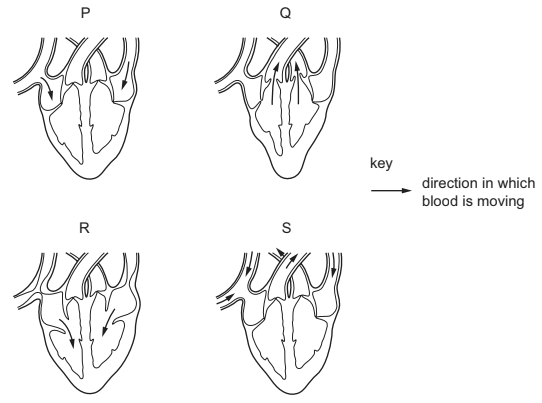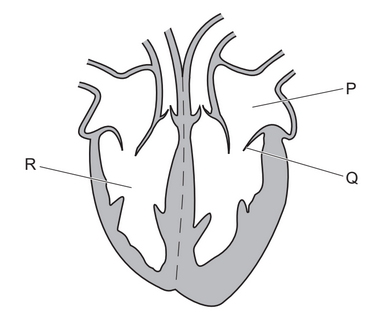Question
The diagram shows a section of the heart.

What is the function of the structure labelled Q?
A It controls the amount of blood leaving the heart.
B It increases the pressure in part R.
C It prevents backflow of blood into part P.
D It prevents blood flowing into the vena cava.
 Answer/Explanation
Answer/Explanation
C
The left ventricle(labeled P) is responsible for pumping oxygenated blood from the left atrium into the aorta, which then distributes the blood to the rest of the body.
The structure which is labeled Q, prevents the backflow of blood into the left atrium. It is mitral valve, also known as the bicuspid valve, located between the left atrium and the left ventricle of the heart. It consists of two cusps or leaflets that open and close to regulate the flow of blood.
When the left ventricle contracts during systole (the pumping phase), the mitral valve closes to prevent blood from flowing back into the left atrium. This closure is important to ensure that blood moves forward into the aorta and to the rest of the body. When the left ventricle relaxes during diastole (the filling phase), the mitral valve opens to allow blood to flow from the left atrium into the left ventricle, preparing for the next contraction.
The proper functioning of the mitral valve is crucial for maintaining the forward flow of blood and preventing backflow, which could lead to conditions such as mitral regurgitation (leaky valve) and decreased cardiac efficiency.

Question
The diagram shows a vertical section through a human heart.

 Answer/Explanation
Answer/Explanation
C
The right atrium and left ventricle are two chambers of the human heart that play important roles in the circulatory system.
1. Right Atrium: The right atrium is one of the four chambers of the heart and is located in the upper part of the heart. It receives deoxygenated blood from the body through two large veins called the superior vena cava (which carries blood from the upper body) and the inferior vena cava (which carries blood from the lower body). The right atrium then contracts, pumping the blood into the right ventricle through a one-way valve called the tricuspid valve.
2. Left Ventricle: The left ventricle is the largest and most muscular chamber of the heart. It is located in the lower part of the heart and receives oxygenated blood from the left atrium through the mitral valve (also known as the bicuspid valve). The left ventricle contracts forcefully to pump the oxygen-rich blood into the aorta, the largest artery in the body. From the aorta, the blood is distributed to the rest of the body’s tissues and organs, supplying them with oxygen and nutrients.
It’s worth noting that the right atrium and left ventricle are connected to each other through the pulmonary circuit. After the right ventricle receives deoxygenated blood from the right atrium, it pumps it into the pulmonary artery. The pulmonary artery carries the blood to the lungs, where it picks up oxygen and releases carbon dioxide. The oxygenated blood then returns to the left atrium from the lungs, and the cycle continues.
Question
The diagrams show four different stages in one heart beat.

What is the correct order for the stages after stage P?
A Q → R → S
B R → Q → S
C R → S → Q
D S → R → Q
▶️Answer/Explanation
B
The four different stages in one heartbeat refer to the cardiac cycle, which represents the complete sequence of events that occur during one heartbeat. The correct order of these stages is as follows:
1. Atrial Contraction (Atrial Systole): The cardiac cycle begins with the contraction of the atria, the two upper chambers of the heart. This contraction pushes blood into the ventricles.
2. Ventricular Contraction (Ventricular Systole): After the atrial contraction, the ventricles, the two lower chambers of the heart, contract. This forces blood out of the heart into the pulmonary artery (from the right ventricle) and the aorta (from the left ventricle) to be distributed throughout the body.
3. Atrial Relaxation (Atrial Diastole): Following the ventricular contraction, the atria start to relax. As they relax, blood begins to flow into the atria from the veins, preparing for the next cardiac cycle.
4. Ventricular Relaxation (Ventricular Diastole): Finally, both the atria and ventricles are in a relaxed state. The ventricles receive blood from the atria, and the whole heart is ready for another cycle as it fills up with blood from the body and lungs.
This sequence of events repeats with every heartbeat, ensuring continuous blood circulation throughout the body. Keep in mind that the heart’s electrical system and valves play essential roles in coordinating and regulating these stages to maintain an effective and efficient pumping action.

Based on this typical sequence, the answer would be
B: R → Q → S
Question
The diagram shows a section through the heart.
Which part pumps blood to the aorta?

▶️Answer/Explanation
C
The part of the heart that pumps blood to the aorta is the left ventricle (C). The heart is divided into four chambers: two atria (left and right) and two ventricles (left and right). When the heart contracts, the left ventricle is responsible for pumping oxygenated blood from the lungs into the aorta, which is the largest artery in the body. From the aorta, the oxygenated blood is distributed to the rest of the body, supplying oxygen and nutrients to various tissues and organs.
Question
Which chamber of the heart has the thickest muscle wall?
A left atrium
B left ventricle
C right atrium
D right ventricle
▶️Answer/Explanation
B
The correct answer is B) left ventricle. The left ventricle has the thickest muscle wall among the four chambers of the heart. This is because it is responsible for pumping oxygenated blood to the rest of the body, which requires a strong contraction force to overcome the resistance of the systemic circulation. The thick muscular wall of the left ventricle helps generate this force and ensures efficient delivery of oxygenated blood to the body’s tissues and organs.
Question
The diagram shows a section through the mammalian heart.
Which labelled structures are arteries?
A 1 and 2 B 1 and 4 C 2 and 3 D 3 and 4
▶️Answer/Explanation
C
In the given diagram of the mammalian heart, the labeled structure that represents an artery is option C, which includes structures 2 and 3. In mammalian heart, arteries are typically labeled based on their location and function. Arteries are blood vessels that carry oxygenated blood away from the heart to various parts of the body. The pulmonary artery is responsible for carrying deoxygenated blood from the heart to the lungs for oxygenation. Therefore, option C, which includes the pulmonary artery, is the correct answer.

Question
The diagram shows the human heart.

In which order does blood pass through the chambers during a complete circuit of the body after
it returns from the lungs?
A Q → R → S → P
B Q → R → P → S
C P → S → Q → R
D P → S → R → Q
▶️Answer/Explanation
B
The correct order in which blood passes through the chambers during a complete circuit of the body after it returns from the lungs is:
B) Q → R → P → S
1. Blood returns from the lungs to the heart, entering the left atrium (Q).
2. From the left atrium, the blood flows into the left ventricle (R) through the mitral valve (also known as the bicuspid valve).
3. The left ventricle contracts, forcing the blood out into the aorta (P) through the aortic valve.
4. From the aorta, the oxygenated blood is distributed to the rest of the body, supplying oxygen and nutrients to various organs and tissues.
5. Deoxygenated blood returns to the heart through the superior and inferior vena cava and enters the right atrium (S).
6. Blood then flows from the right atrium to the right ventricle (S).
7. The right ventricle contracts, pumping the deoxygenated blood into the pulmonary artery, which takes the blood back to the lungs for oxygenation.
So, the correct order is Q → R → P → S.
Question
On which organ is an ECG performed?
A brain
B colon
C ear
D heart
▶️Answer/Explanation
D) heart
An electrocardiogram (ECG or EKG) is a medical test that is performed on the heart. It records the electrical activity of the heart and helps evaluate its function and detect any abnormalities. By placing electrodes on specific locations of the body, usually on the chest, arms, and legs, the ECG machine measures and produces a graphical representation of the electrical signals generated by the heart. This allows healthcare professionals to diagnose various heart conditions and monitor the heart’s health.
Question
The diagram shows a section through the heart.
What is the function of the structure labelled Q?
A It controls the amount of blood leaving the heart.
B It increases the pressure in part R.
C It prevents backflow of blood into part P.
D It prevents blood flowing into the vena cava.
Answer/Explanation
Ans : C
Question
The diagram shows a section through the heart.
What is the function of the structure labelled Q?
A It controls the amount of blood leaving the heart.
B It increases the pressure in part R.
C It prevents backflow of blood into part P.
D It prevents blood flowing into the vena cava.
▶️Answer/Explanation
C
The left ventricle(labeled P) is responsible for pumping oxygenated blood from the left atrium into the aorta, which then distributes the blood to the rest of the body.
The structure which is labeled Q, prevents the backflow of blood into the left atrium. It is mitral valve, also known as the bicuspid valve, located between the left atrium and the left ventricle of the heart. It consists of two cusps or leaflets that open and close to regulate the flow of blood.
When the left ventricle contracts during systole (the pumping phase), the mitral valve closes to prevent blood from flowing back into the left atrium. This closure is important to ensure that blood moves forward into the aorta and to the rest of the body. When the left ventricle relaxes during diastole (the filling phase), the mitral valve opens to allow blood to flow from the left atrium into the left ventricle, preparing for the next contraction.
The proper functioning of the mitral valve is crucial for maintaining the forward flow of blood and preventing backflow, which could lead to conditions such as mitral regurgitation (leaky valve) and decreased cardiac efficiency.
